The Evolution of Candidate Engagement (From Someone Who Speaks English as a Third Language)
November 30, 2023 8 min read
Written by Steven Jiang, CEO of hireEZ
In October, I had the pleasure of presenting at HR Tech 2023 on the topic of candidate engagement and its critical importance for business success.
I wanted to share some of the insights I shared on stage and the feedback I've received since.
If we have not had the chance to meet, I want to say hello and give a brief introduction about myself.
My name is Steven Jiang. First and foremost, I am a very proud husband and father.
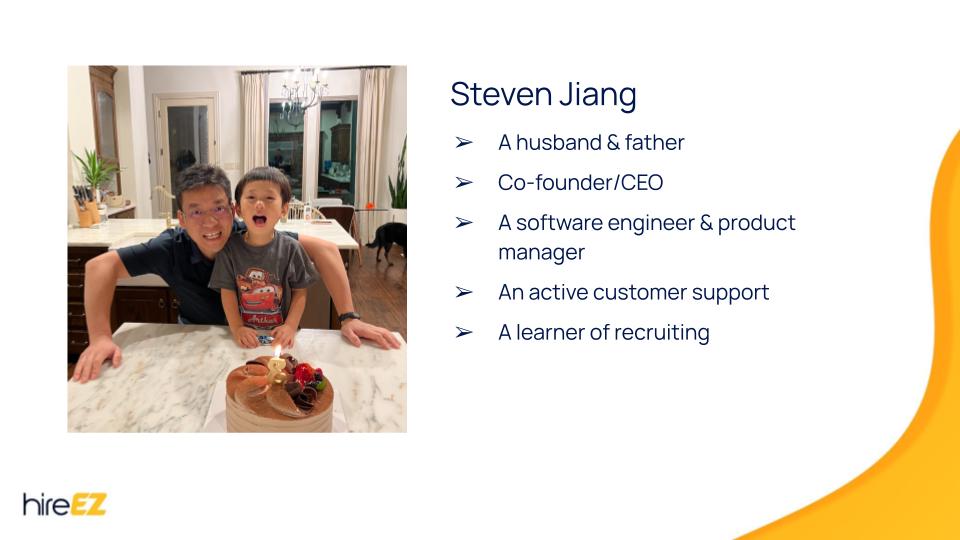
As you can see above, this is my son Arthur (or, as he likes to be known as, “Spiderman” in my house). Every day when he returns from school, he always says, “you are the bad guy, I'm going to catch you.”
My background began as a software engineer, where I became a lifelong learner of recruiting. In fact, it's that passion for helping people find jobs that led me to co-found hireEZ. Today, I'm proud that we serve thousands of customers globally.
To be honest, when my team told me that I had to speak on stage I was very confused. We have much more competent speakers at our company with years of presentation experience, like Shannon Pritchett.
Not to mention, English is my third language! I was certain I wouldn't be able to pull it off, but then my team told me that I have a unique perspective to offer given my own personal experience with learning to engage and connect with others.
So before I talk about the evolution of candidate engagement, here's my story.
I was born in a very small village in the south of China. And my first language is Hakka. So for the first nine years, I spoke Hakka only… not even Mandarin. That was my second language.
In a village as small as mine, the engagement between people was fantastic. Every piece of gossip was a big story. And after dinner, everyone sat on big stones and talked about everything. The ability to engage was great.
By the way, this was me.

With a suit like that, it's clear that my parents thought I'd be a CEO.
It wasn't until I turned 13 that I started learning English. Learning a new language is challenging. Not just because of the words and sounds but also because of the meaning behind them.
As you all know, English is complex at times. The same words and phrases can mean so many different things, and to this day, I'm still trying to understand the phrases that so many of you use.
In fact, this complexity led to disaster while emailing the VP of Engineering at Samsung.
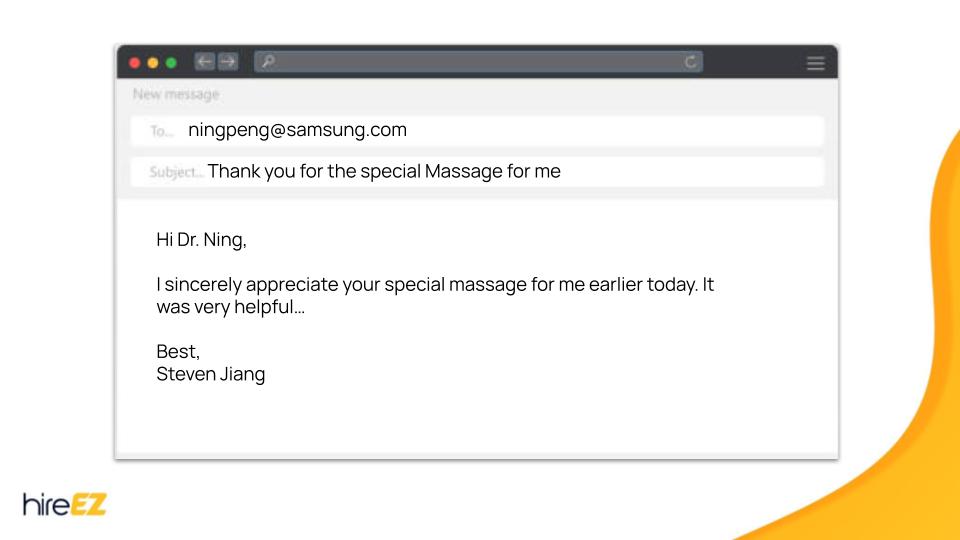
After I sent this message, he said to me, “Steven, something's wrong. You've got to delete this. I didn't give you any special service.”
I meant to say message (not massage) and when I googled what I wrote, I was so embarrassed.
Fast forward to today, I've built a company with over 200 employees. And while it'd be easy to think that the strength of our product has driven our success and impact in the industry, we all know that people are any company's most valuable asset.
Fundamentally, more than anything – my job has been to inspire our employees with our vision, communicate our goals effectively and ensure that everyone in our organization feels engaged and heard.
I bring up my backstory and journey with English because I realize how critical it is to connect with people and speak to them in a way they understand — especially not being able to for so long.
In my case, that disconnect is a language barrier. For many leaders and professionals in talent acquisition, the disconnect with talent is because the fundamental value placed on effective engagement is falling short.
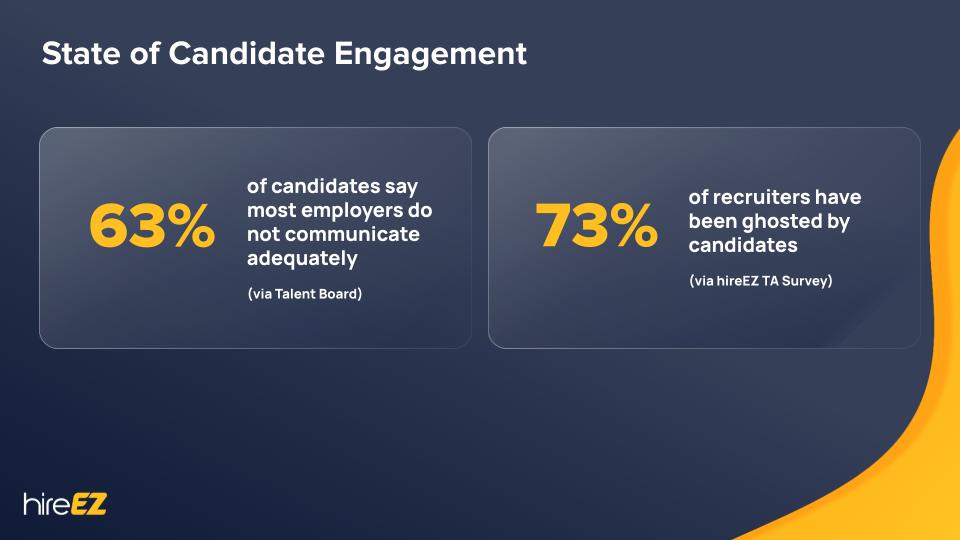
How do we know? Well, we conducted a very extensive survey earlier this year. Seventy-three percent of the recruiters had been ghosted by candidates. But complaints are always a two-way street, right? On the other hand, Sixty-three percent of candidates also complained that recruiters did not communicate adequately.
Let's see how recruiters and talent acquisition teams reacted to this problem.
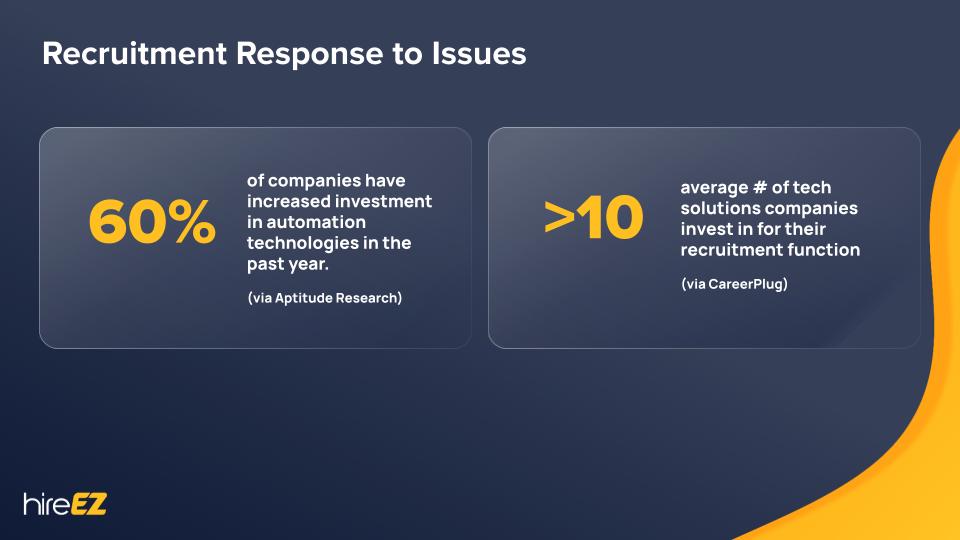
Sixty percent of the companies have increased investment into technology, and companies use more than ten solutions, on average. In other words, the response has been technology investments.
And you might think, as a founder and CEO of a tech company, this is great news to you? However, I'm always reminded of this quote:
“Most digital technologies provide possibilities for efficiency gains and customer intimacy. But if people lack the right mindset to change and the current organizational practices are flawed, digital transformation will simply magnify those flaws.”
And I believe it. Digital transformation will simply magnify flaws. So let's start with the basics…
What does it mean to engage?
No one ever says, “This candidate has been communicated with.” You always say this candidate has been engaged, right?
Why the difference?
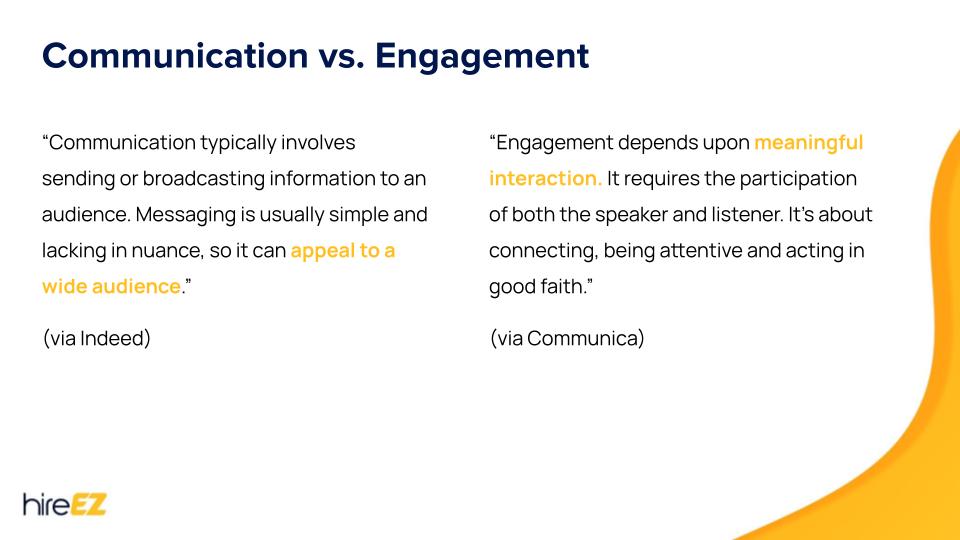
Engagement is more about meaningful interactions and it requires participation from both sides, the speaker and also the listener. However, there's a misunderstanding between what recruiters want with candidates and what recruiters are doing.
A 2023 LinkedIn survey cited communication as the most desired soft skill cited for recruiters in the next five years… not engagement.
Here's what industry veteran and our Head of Community, Shannon Pritchett, shared about the recruiter shift in mindset with engagement.
“What I found was that there's a fundamental desire for recruiters to get away from the speed and the necessity to quickly find candidates and shift more towards the engagement side of things. And the passion and the desire right now is coming from the stem that recruiters are having a difficult time engaging with them.
How do you stand out? How do you make yourself look different in a very busy inbox, right? I think recruiters have been so reliant on a particular tool, like let's say a LinkedIn recruiter, right? Every single inmail, email, looks exactly the same.
That's the new age of communication and the new age of engagement. So it's no longer how fast we can find a candidate, it's about how quickly we can respond and have that conversation with us.”
Shannon nailed it. But the question becomes, how do we ensure candidate engagement is successful?
Crafting a Candidate Engagement Playbook
From the CEO to the recruiter, there needs to be a centralized playbook for candidate engagement.
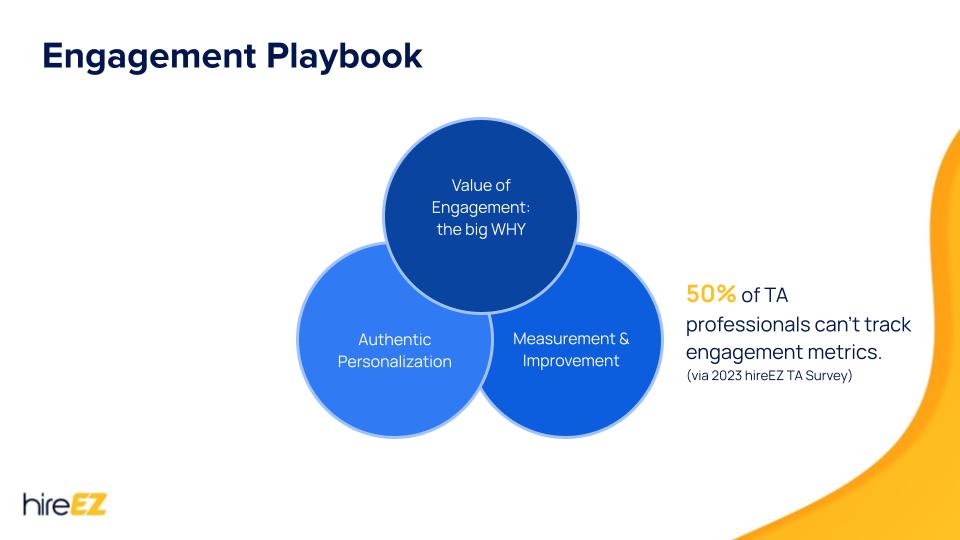
That playbook should cover three things.
The value of engagement
: In other words, “why” is engagement essential. Technology won't help much if the organization isn't bought in for doing what's necessary to effectively engage.Authentic personalization:
No more copy-paste emails that start with “Hope this email finds you well.” This is something chatGPT can easily do for you. Instead, create messaging about what's unique to the values and mission at your company. If your message is not authentic, it will not work.Measurement and improvement:
We need to show success metrics and establish benchmarks so we know what messaging works and what doesn't. Unfortunately, we found that 50% of TA teams don't have access to engagement metrics. If we can't measure, we cannot improve.
Challenges in the Way of Playbook Execution
Even if you have a foundational playbook for what it takes to engage — your existing resources are not set up to let you execute.
- Resource Constraints
- Clunky Systems
In a recent case study with WilsonHCG, Greg McKoewn, Sr. Director of Innovation and Customer Success, told us “Recruiters have consistently seen their requisition loads increase over time as companies tend to want to do more with less.” He added that the resources that do remain can be “disjointed tools that sometimes never get used.”
Three Necessities of Engagement Technology
With this in mind, engagement technology needs to encompass three key things.
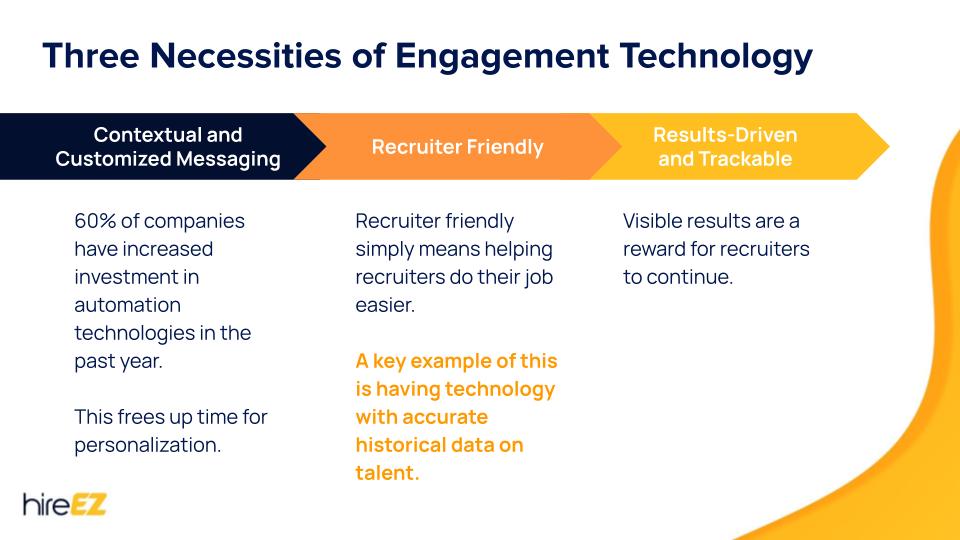
One thing to point out is that a lot of engagement technology made promises to help in these areas but fell short. In fact, CRMs in particular made promises to consolidate and centralize data in one place, but we always hear complaints about not being able to look up history information clearly.
Once your playbook and technology are in place, they actually work together.
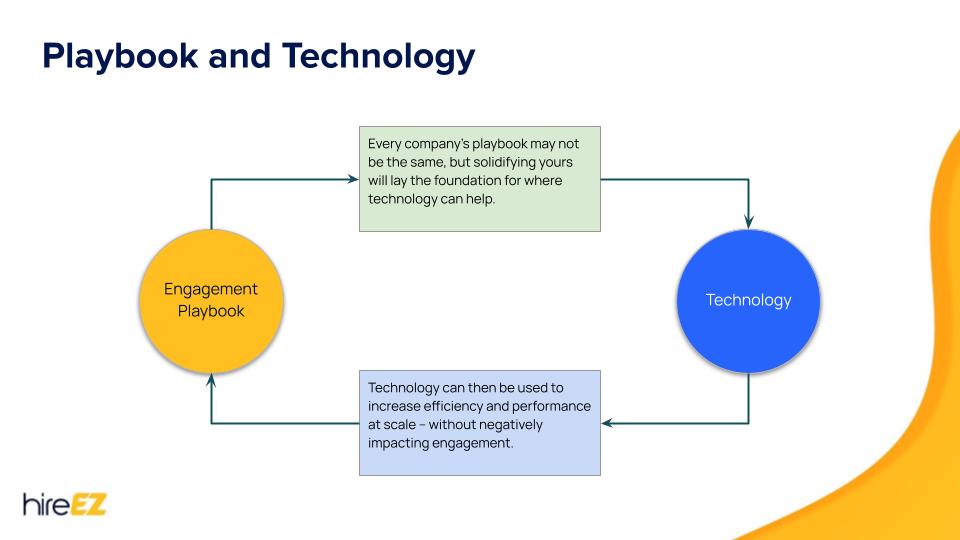
The playbook powers the technology you use to execute on it and the technology can then be used to increase the effectiveness of the playbook. They constantly iterate and improve one another.
But there is still one major challenge that can stop this flywheel from working.
Change management.
Our friend Greg McKeown also told us that, “It was tough at first - because of the whole fear of ‘I’m on xyz platform every day, and you’re telling me I can’t search and message there’ - that it took a little bit of time to adopt hireEZ. But once people started using it and saw success it was like a fire that spread slowly.”
This is a problem everywhere. Even if technology and processes are in place, a lack of usage and training around those two areas can lead to a lack of results.
Because we have to remember that people are always at the center of any strategy.
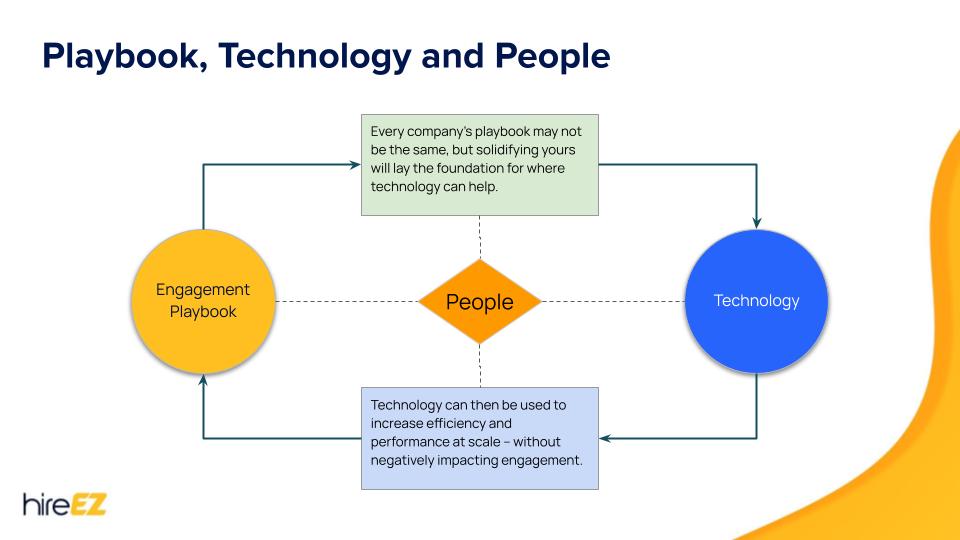
Without them, businesses can't function, let alone your candidate engagement strategy.
We still need to put recruiters, hiring managers and others at the center start to become reasonable, logical, and have an engagement function that starts to work.
If you're looking to improve your engagement success, learn more about hireEZ's engagement capabilities.
newsletter
Subscribe for our daily news
By filling out this form you agree to hireEZ's Privacy Policy and consent to receive communications from hireEZ.
Outbound Recruiting
newsletter
Subscribe for our daily news
By filling out this form you agree to hireEZ's Privacy Policy and consent to receive communications from hireEZ.
Stay Up-to-Date on Future Talent Acquisition Events
By filling out this form you agree to hireEZ's Privacy Policy and consent to receive communications from hireEZ.
related BLOGS
videos
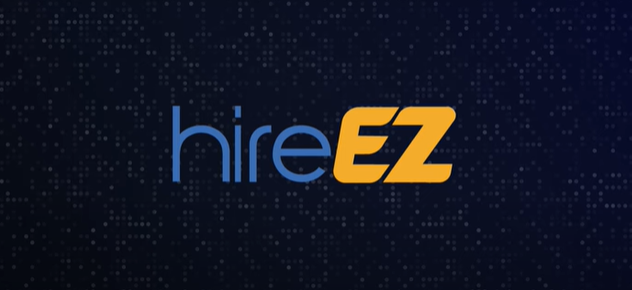
hireEZ - Outbound Recruiting Made Easy!

A Hiring Superhero Rebrand Made EZ